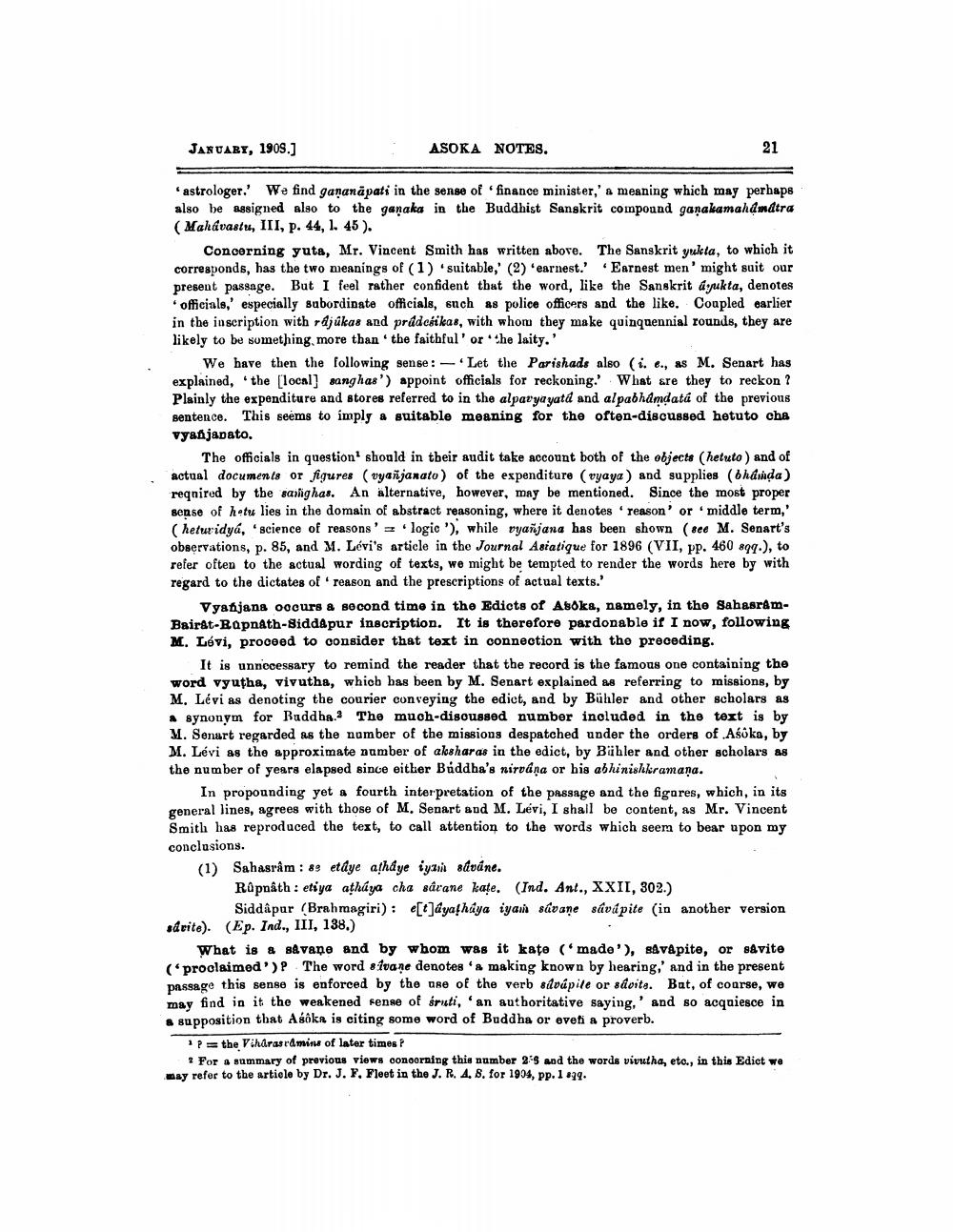________________
JANUARY, 1903.)
ASORA NOTES.
21
astrologer.' We find gananā pati in the sense of finance minister,' a meaning which may perhaps also be assigned also to the ganaka in the Buddhist Sanskrit compound ganakamahậmdtra (Mahavastu, III, p. 44, 1. 45).
Concerning yuta, Mr. Vincent Smith has written above. The Sanskrit yukla, to which it corresponds, has the two meanings of (1) 'suitable,' (2) 'earnest.' Earnest men' might sait our present passage. But I feel rather confident that the word, like the Sanskrit dyukta, denotes
officials,' especially subordinate officials, such as police officers and the like. Coupled earlier in the inscription with rájúkas and prádcsikas, with whom they make quinquennial rounds, they are likely to be something more than the faithful' or she laity.'
We have then the following sense: - Let the Parishads also (i. e., as M. Senart has explained, the (local) sanghas') appoint officials for reckoning.' What are they to reckon ? Plainly the expenditure and stores referred to in the alparya yatd and alpabh&mdatá of the previous sentence. This seems to imply a suitable meaning for the often-discussed hetuto cha vyañjapato.
The officials in question should in their audit take account both of the objects (hetuto ) and of actual documents or figures (vyañjanato) of the expenditure (vyaya) and supplies (bhavada) reqnired by the saiighas. An alternative, however, may be mentioned. Since the most proper sense of hetu lies in the domain of abstract reasoning, where it denotes reason' or middle term, (hetur idya, science of reasons' = logic '), while vyañjana has been shown (see M. Senart's observations, p. 85, and M. Lévi's article in the Journal Asiatique for 1896 (VII, pp. 460 899.), to refer often to the actual wording of texts, we might be tempted to render the words here by with regard to the dictates of reason and the prescriptions of actual texts.'
Vyanjana occurs a second time in the Edicts of Asoka, namely, in the SahasramBairat-Rapnath-Siddapur inscription. It is therefore pardonable if I now, following M. Lévi, proceed to consider that text in connection with the preceding.
It is unniccessary to remind the reader that the record is the famous one containing the word vyutha, vivutha, which has been by M. Senart explained as referring to missions, by M. Lévi as denoting the courier conveying the edict, and by Bühler and other scholars as * synonym for Buddha. The much-disoussed number included in the text is by M. Senart regarded as the number of the missions despatched under the orders of Asoka, by M. Lévi as the approximate number of aksharas in the edict, by Bühler and other scholars as the number of years elapsed since either Buddha's nirvana or his abhinishkramana.
In propounding yet a fourth interpretation of the passage and the figures, which, in its general lines, agrees with those of M. Senart and M. Levi, I shall be content, as Mr. Vincent Smith has reproduced the text, to call attention to the words which seem to bear upon my conclusions. (1) Sahasram : 89 et dye athaye iyi sáváne.
Räpnath : etiya athúya cha särane kațe. (Ind. Ant., XXII, 302.)
Siddapur (Brahmagiri): e[t]dyafhaya iyai savane sävd pite (in another version sdrite). (Ep. Ind., III, 138.)
What is & såvane and by whom was it kate (made'), såväpite, or såvite (proclaimed')? The word sivane denotes 'a making known by hearing,' and in the present passage this sense is enforced by the use of the verb sdvápile or doite. Bat, of course, we may find in it the weakened sense of śruti, 'an authoritative saying,' and so acquiesce in & supposition that Asoka is citing some word of Buddha or eveti a proverb.
i =the Viharasramins of later times ?
? For a summary of previous views oonoorning this number 29 and the words vivutha, etc., in this Edict we may refer to the article by Dr. J. F. Fleet in the J. R. 4. 8. for 1904, pp. 1999.




